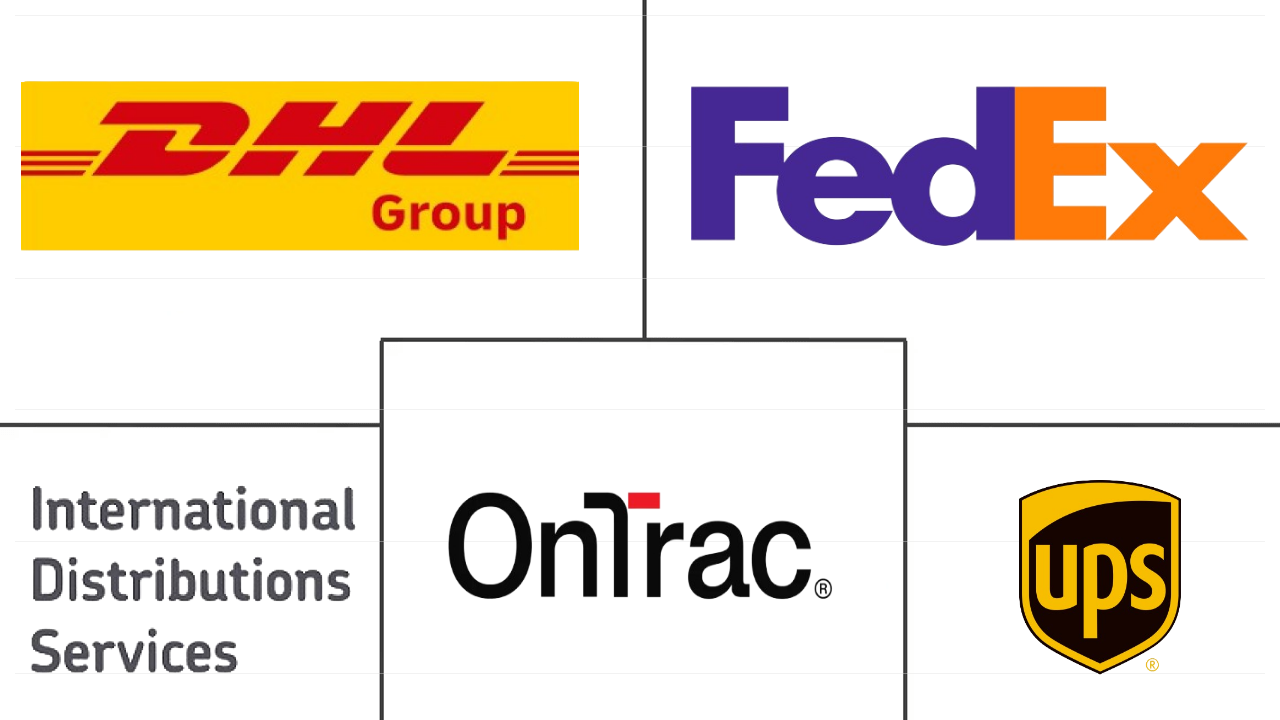Market Size of north america international express service Industry
| Icons | Lable | Value |
|---|---|---|
|
|
Study Period | 2017 - 2030 |
|
|
Market Size (2024) | USD 10.79 Billion |
|
|
Market Size (2030) | USD 15.12 Billion |
|
|
Largest Share by End User Industry | E-Commerce |
|
|
CAGR (2024 - 2030) | 5.79 % |
|
|
Largest Share by Country | United States |
|
|
Market Concentration | Medium |
Major Players |
||

|
||
|
*Disclaimer: Major Players sorted in no particular order |
North America International Express Service Market Analysis
The North America International Express Service Market size is estimated at 10.79 billion USD in 2024, and is expected to reach 15.12 billion USD by 2030, growing at a CAGR of 5.79% during the forecast period (2024-2030).
10.79 Billion
Market Size in 2024 (USD)
15.12 Billion
Market Size in 2030 (USD)
5.56 %
CAGR (2017-2023)
5.79 %
CAGR (2024-2030)
Fastest Growing Market by End User Industry
6.58 %
Projected CAGR, E-Commerce, 2024-2030
The growth of the North American e-commerce market for CEP, specifically cross-border e-commerce, is due to a rise in demand for high-quality products from global players.
Fastest Growing Market by Shipment Weight
6.05 %
Projected CAGR, Light Weight Shipments, 2024-2030
The significant value of imports and exports of pharmaceutical goods in the region is largely driving the segment's growth rapidly.
Largest Market by Shipment Weight
68.99 %
value share, Light Weight Shipments, 2023
The import and export of pharmaceutical products in the region are majorly driving the demand for delivery under the lightweight shipment segment.
Largest Market by End User Industry
50.53 %
value share, E-Commerce, 2023
The rising consumer demand for high-quality products at competitive rates, which has fueled cross-border e-commerce growth, is significantly driving the segment's growth.
First leading Market player
30.63 %
market share, DHL Group, 2022

DHL has opened a new regional hub located in Atlanta, United States. DHL Aero Expresso Panama has been declared the primary carrier between the United States and South America.
The e-commerce sector is fueling the international express service market's growth in North America
- The e-commerce growth fueled the international express service market in North America as consumers ordered more online. With more consumers moving from offline to online shopping, courier companies have witnessed a rise in businesses delivering goods amid the COVID-19 pandemic restrictions. Growth in cross-border e-commerce in North America is expected to drive the market. As of 2022, only 3% of e-commerce revenue was from cross-border transactions in the United States and Canada. Whereas in Mexico, cross-border accounted for 5% of e-commerce revenue. Over the upcoming years, cross-border B2C e-commerce in North America is expected to expand gradually.
- As of 2022, 26% of US retailers offered same-day delivery, and an additional 73% planned to add the service within the next three years. Furthermore, Mexico offers an abundance of opportunities for Canadian businesses. The shifting preferences of Mexico's population, which now prioritizes high-quality products, are perfectly aligned with Canada's retail strengths. Also, small retail businesses are benefitting from reduced expenses by express delivery carriers in the United States, resulting from the implementation of the United States-Mexico-Canada Agreement (USMCA).
- The demand for international same-day delivery in Canada via air is driven by goods like pharmaceuticals and other health products, which are expected to grow by 11.3% per year through 2025. Additionally, the growth of cross-border e-commerce for products like first-aid items, hearing aids, and biometric monitors, is also expected to drive the growth of the international express service market in the region.
Toronto-Windsor-Detroit-Chicago corridor and Pan-American Highway facilitating regional parcel deliveries
- The United States leads the North American international express service market, along with Canada, Mexico and other countries. The growing preference for online shopping and demand generated by end-users such as BFSI sector, healthcare, manufacturing among others has driven the regional market demand. Around 50% of US-based companies receive more than 80% of e-commerce revenue from the North American market.
- The Toronto-Windsor-Detroit-Chicago corridor is one of the densest and most integrated within the intra-region framework. Laredo inland port is a major gateway into Mexico. In Canada, the Trans-Canada Highway offers a coast-to-coast route, while from Mexico, the Pan-American Highway links the countries of Central America. These highways have enabled trucks to take over short-haul routes from railways while the railways concentrate on long-haul, low-cost routes. The Northwest Seaport Alliance facilitates the transshipment of goods from North America to the rest of the world. The small packet international air service of Canada facilitates shipment of lightweight parcels up to 2 kgs.
- Many retailers in the United States currently provide international same-day delivery services due to increased customer demand with priority delivery requirements. Retailers are providing international same-day delivery services, specifically via air cargo, to more than 200 locations globally. Time-sensitive shipments and other perishables are also driving international express deliveries in Canada via air. Mexico announced its plans to move its air cargo airport from Mexico City International Airport (AICM) to Felipe Ángeles International Airport (AIFA) in 2023 for exclusive cargo shipments, which may improve international same-day deliveries.
North America International Express Service Industry Segmentation
Heavy Weight Shipments, Light Weight Shipments, Medium Weight Shipments are covered as segments by Shipment Weight. Inter-Region, Intra-Region are covered as segments by Route. E-Commerce, Financial Services (BFSI), Healthcare, Manufacturing, Primary Industry, Wholesale and Retail Trade (Offline), Others are covered as segments by End User Industry. Canada, Mexico, United States are covered as segments by Country.
- The e-commerce growth fueled the international express service market in North America as consumers ordered more online. With more consumers moving from offline to online shopping, courier companies have witnessed a rise in businesses delivering goods amid the COVID-19 pandemic restrictions. Growth in cross-border e-commerce in North America is expected to drive the market. As of 2022, only 3% of e-commerce revenue was from cross-border transactions in the United States and Canada. Whereas in Mexico, cross-border accounted for 5% of e-commerce revenue. Over the upcoming years, cross-border B2C e-commerce in North America is expected to expand gradually.
- As of 2022, 26% of US retailers offered same-day delivery, and an additional 73% planned to add the service within the next three years. Furthermore, Mexico offers an abundance of opportunities for Canadian businesses. The shifting preferences of Mexico's population, which now prioritizes high-quality products, are perfectly aligned with Canada's retail strengths. Also, small retail businesses are benefitting from reduced expenses by express delivery carriers in the United States, resulting from the implementation of the United States-Mexico-Canada Agreement (USMCA).
- The demand for international same-day delivery in Canada via air is driven by goods like pharmaceuticals and other health products, which are expected to grow by 11.3% per year through 2025. Additionally, the growth of cross-border e-commerce for products like first-aid items, hearing aids, and biometric monitors, is also expected to drive the growth of the international express service market in the region.
| Shipment Weight | |
| Heavy Weight Shipments | |
| Light Weight Shipments | |
| Medium Weight Shipments |
| Route | |
| Inter-Region | |
| Intra-Region |
| End User Industry | |
| E-Commerce | |
| Financial Services (BFSI) | |
| Healthcare | |
| Manufacturing | |
| Primary Industry | |
| Wholesale and Retail Trade (Offline) | |
| Others |
| Country | |
| Canada | |
| Mexico | |
| United States | |
| Rest of North America |
North America International Express Service Market Size Summary
The North America International Express Service Market is experiencing significant growth, driven by the surge in e-commerce and the shift from offline to online shopping. This transition has been particularly pronounced during the COVID-19 pandemic, which accelerated the demand for courier services. The market is further bolstered by the expansion of cross-border e-commerce, with the United States, Canada, and Mexico leading the charge. The region's infrastructure, including key highways and ports, supports the efficient movement of goods, while agreements like the United States-Mexico-Canada Agreement (USMCA) have reduced costs for small retailers. The demand for same-day delivery services, especially for pharmaceuticals and health products, is on the rise, with Canada and the United States at the forefront of this trend.
The market is moderately consolidated, with major players such as DHL Group, FedEx, and UPS dominating the landscape. These companies are expanding their operations to meet the growing demand for international express services. Investments in infrastructure, such as Mexico's plans to enhance its air cargo capabilities and the United States' port facility improvements, are expected to further boost the market. Despite challenges like rising fuel prices, which impact transportation costs, the market continues to thrive due to strategic investments and the increasing preference for online shopping. The North American market's robust growth trajectory is supported by its strong economic foundations and the ongoing digital transformation in retail.
North America International Express Service Market Size - Table of Contents
-
1. MARKET SEGMENTATION (includes Market Value in USD, Forecasts up to 2030 and analysis of growth prospects)
-
1.1 Shipment Weight
-
1.1.1 Heavy Weight Shipments
-
1.1.2 Light Weight Shipments
-
1.1.3 Medium Weight Shipments
-
-
1.2 Route
-
1.2.1 Inter-Region
-
1.2.2 Intra-Region
-
-
1.3 End User Industry
-
1.3.1 E-Commerce
-
1.3.2 Financial Services (BFSI)
-
1.3.3 Healthcare
-
1.3.4 Manufacturing
-
1.3.5 Primary Industry
-
1.3.6 Wholesale and Retail Trade (Offline)
-
1.3.7 Others
-
-
1.4 Country
-
1.4.1 Canada
-
1.4.2 Mexico
-
1.4.3 United States
-
1.4.4 Rest of North America
-
-
North America International Express Service Market Size FAQs
How big is the North America International Express Service Market?
The North America International Express Service Market size is expected to reach USD 10.79 billion in 2024 and grow at a CAGR of 5.79% to reach USD 15.12 billion by 2030.
What is the current North America International Express Service Market size?
In 2024, the North America International Express Service Market size is expected to reach USD 10.79 billion.

